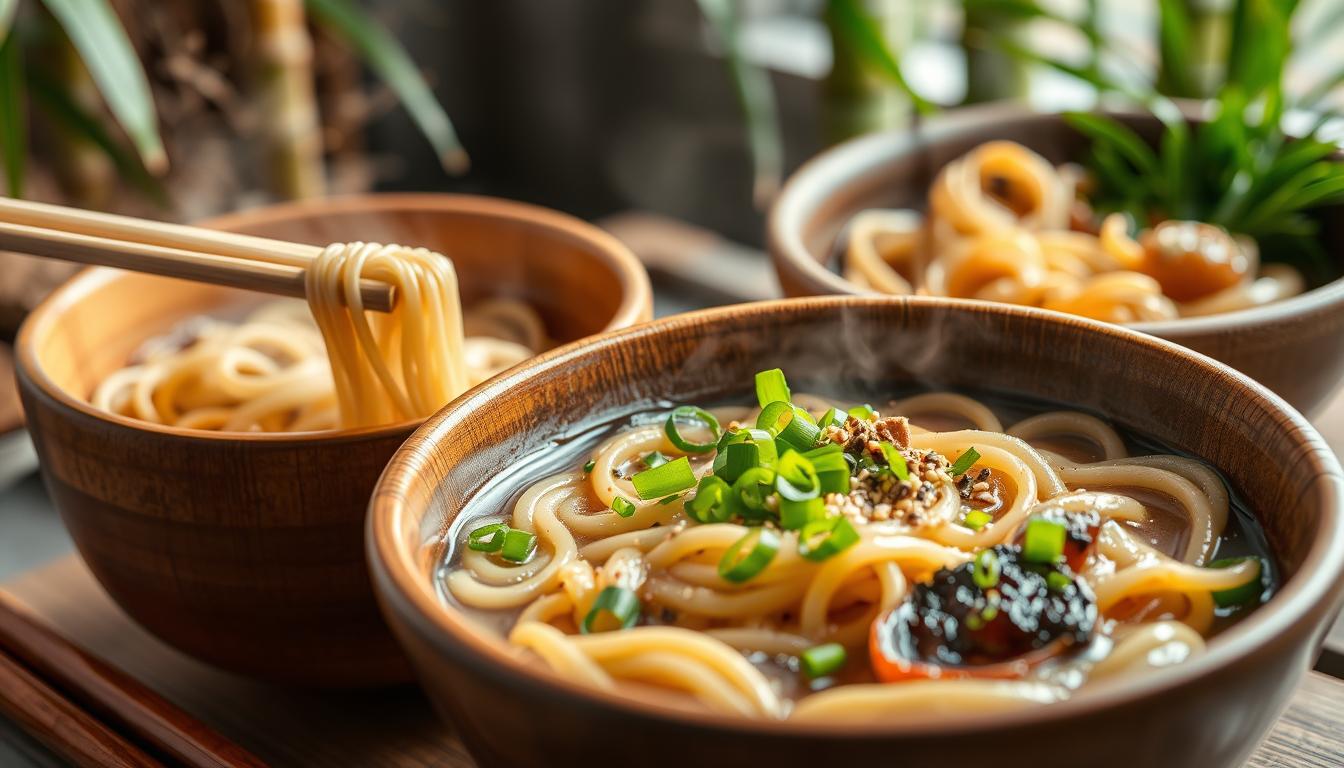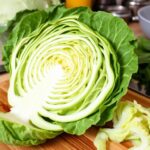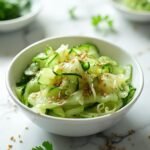Soba and udon noodles are famous Japanese noodle types that are loved globally. They have unique ingredients, textures, flavors, and uses in cooking. Knowing the differences between soba and udon can help you choose the right one for your meals.
- Introduction to Japanese Noodles
- What are Soba Noodles?
- Popular Soba Noodle Dishes
- What are Udon Noodles?
- Types of Udon Noodles
- Popular Udon Noodle Dishes
- Soba Noodles vs Udon Noodles – What is the Difference?
- Cooking and Serving Soba vs Udon
- Soba Noodles vs Udon Noodles – Which is Healthier?
- Cultural Significance and Traditions
- Conclusion
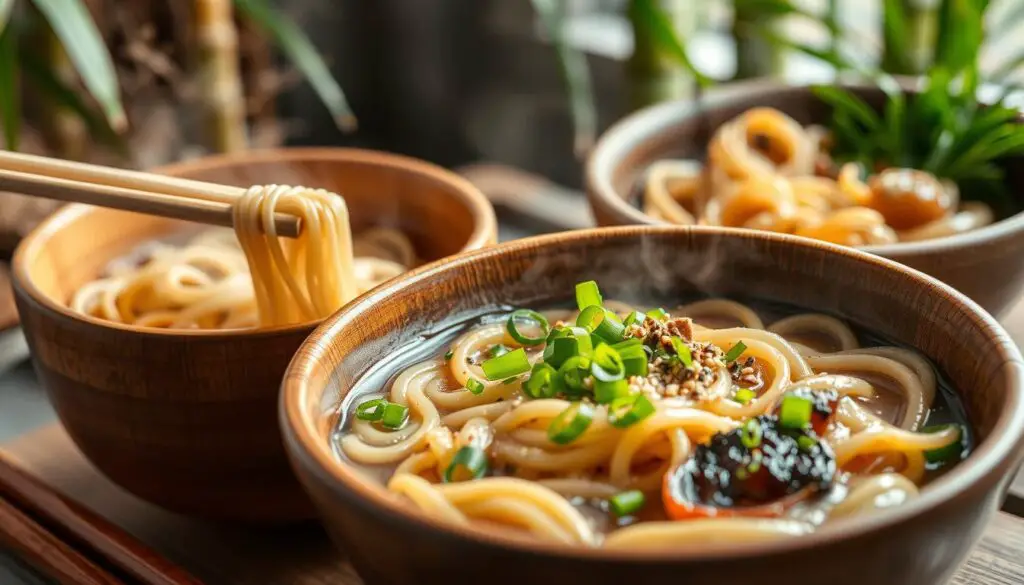
Soba noodles mix buckwheat flour with wheat flour. Udon noodles are mostly wheat flour, water, and salt. Buckwheat in soba adds nutrients like B vitamins and rutin, good for blood pressure.
Soba noodles look darker and are thinner than udon. Udon noodles are white and thick. Soba has more fiber. Udon noodles soak up water, getting bigger and tasting neutral, perfect for many dishes.
Introduction to Japanese Noodles
Japan is famous for its wide variety of noodle dishes. Soba and udon noodles are two of the most beloved. They differ in ingredients, texture, and how they’re used in cooking.
Exploring the Diverse World of Japanese Noodles
Japan has more than just soba and udon noodles. There’s ramen, somen, and many others. Each noodle has its taste, texture, and cooking method. Exploring these noodles is a fun food adventure.
Soba and Udon: Two Iconic Noodle Varieties
Soba and udon are at the heart of Japanese noodle culture. Soba noodles are made from buckwheat flour, giving them a nutty taste. Udon noodles, made from wheat flour, are thicker and chewier.
“Ramen is considered the strongest example of Chinese influence in Japanese cuisine, while udon ranks as the second most popular type of Japanese noodle after ramen.”
What are Soba Noodles?
Soba noodles are a favorite in Japan, made from buckwheat flour. They have a nutty taste and a springy feel. Originally, they were 100% buckwheat, but now they mix buckwheat with wheat flour for better texture.
Ingredients and Composition of Soba Noodles
The main part of soba noodles is buckwheat flour, making up at least 30%. Wheat flour is added to make the dough easier to work with. Water is mixed in to create the dough.
Varieties of Soba Noodles
- Nihachi Soba: A classic type with 80% buckwheat and 20% wheat, giving a strong buckwheat taste and a firmer texture.
- Juwari Soba: The truest soba, made from 100% buckwheat, for a lighter, nuttier flavor.
- Blended Soba: These have less buckwheat, 30% to 50%, mixed with wheat for a softer feel.
| Soba Noodle Variety | Buckwheat Flour Content | Flavor and Texture |
|---|---|---|
| Nihachi Soba | 80% | Robust buckwheat flavor, firm bite |
| Juwari Soba | 100% | Delicate, grainy texture, pronounced nutty taste |
| Blended Soba | 30% – 50% | More pliable and forgiving texture |
Soba noodles are loved for their special taste and chewy texture. They are a key part of Japanese cooking.
Popular Soba Noodle Dishes
Soba noodles are a favorite in Japanese food. They’re made from buckwheat flour, which is full of nutrients. You can enjoy them in many tasty ways, both hot and cold.
Zaru soba is a hit, with chilled noodles on a bamboo tray and a savory sauce on the side. It’s perfect for hot summer days because of its refreshing taste.
Kake soba is great for a cozy meal. It’s soba noodles in a flavorful broth, topped with meat or tempura. Kitsune soba is another favorite, with soba noodles and sweet fried tofu.
Tempura soba is amazing too. It combines soba noodles with the crunchy texture of tempura vegetables or shrimp. This dish is a perfect mix of flavors.
Toshikoshi soba is a special dish for New Year’s Eve in Japan. It’s believed to bring a long and prosperous life in the coming year.
Whether you want something cool or warm, soba noodles have you covered. They’re perfect for any time of the year.
| Soba Noodle Dish | Description |
|---|---|
| Zaru Soba | Cold soba noodles served with a dipping sauce |
| Kake Soba | Hot soba noodles in a savory broth |
| Kitsune Soba | Soba noodles with sweet fried tofu |
| Tempura Soba | Soba noodles served with a side of tempura |
| Toshikoshi Soba | Soba noodles eaten on New Year’s Eve as a symbol of longevity |
What are Udon Noodles?
Udon noodles are a favorite in Japan, known for their thick, chewy texture and mild taste. They are made mainly from wheat flour, water, and salt. This makes them different from soba noodles, which include buckwheat.
Ingredients and Composition of Udon Noodles
The main parts of udon noodles are wheat flour, water, and salt. This mix gives them a soft, bouncy feel that soaks up flavors well. A special type, Sanuki udon, comes from Kagawa Prefecture. It’s famous for its chewy texture, thanks to a unique kneading method.
| Ingredient | Composition |
|---|---|
| Wheat Flour | The main part, giving udon noodles their structure and texture. |
| Water | Key for mixing the flour and making the dough. |
| Salt | It adds flavor and helps make the noodles chewy. |
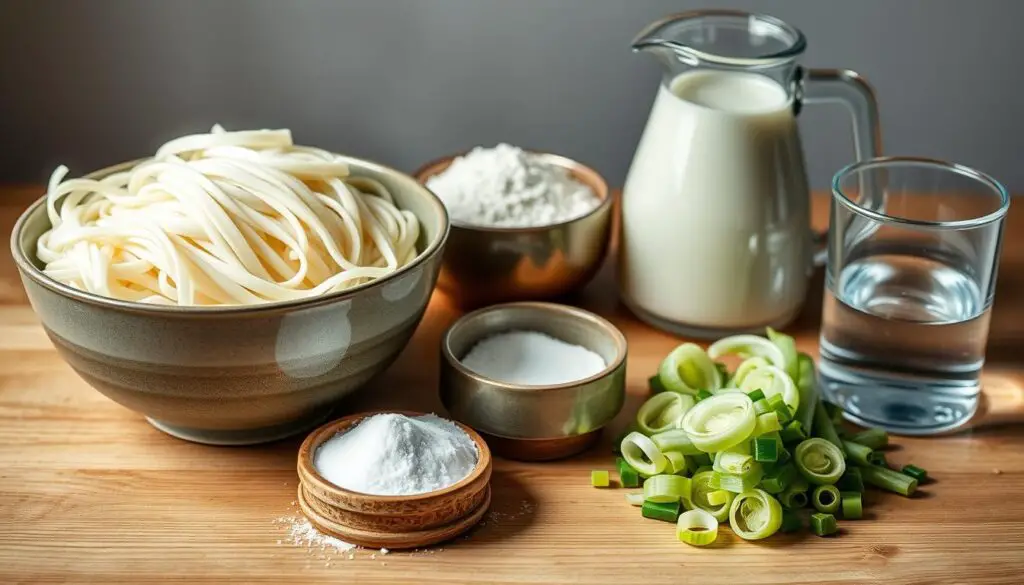
Unlike soba noodles, udon noodles don’t have buckwheat. This makes them great for those who want a wheat-based noodle. They have a soft, slippery texture that goes well with many broths and toppings.
Types of Udon Noodles
Udon noodles are a favorite in Japanese food. They come in shapes like round, flat, and extra-thick. Each type gives a different feel to your food.
Fresh udon noodles are known for their chewy texture. They’re a hit in traditional Japanese places. On the other hand, dried udon and frozen udon are easy to use at home. They let you enjoy udon’s taste quickly.
- Round Udon: The most common type, round udon noodles have a smooth, cylindrical shape that is perfect for absorbing the flavors of broth and toppings.
- Flat Udon: These wide, flat noodles offer a unique texture and are often used in stir-fry dishes or served chilled with a dipping sauce.
- Extra-Thick Udon: As the name suggests, these hearty noodles are thicker and provide a more substantial, chewy bite, making them a satisfying choice for heartier udon dishes.
Udon noodles are made from wheat flour, salt, and water. This simple mix makes them a great base for many Japanese dishes.
Popular Udon Noodle Dishes
Udon noodles are known for their thick and chewy texture. They are the base of many tasty Japanese dishes. You can find them in hot broths or chilled, making them a favorite for many.
Nabeyaki udon is a favorite, with noodles cooked in a hot broth. It’s filled with veggies and tempura shrimp or chicken. Another classic is kitsune udon, which has udon in a savory broth with fried tofu.
- Kake udon is simple yet tasty, served in hot or cold broth.
- Zaru udon is refreshing, with chilled udon and a flavorful dipping sauce.
- Curry udon is a heartier option, with noodles in a rich curry sauce.
- Yaki udon shows the noodles’ versatility in stir-fries. Natto udon pairs them with fermented soybeans for a unique taste.
Udon noodles are great at soaking up flavors from broths, sauces, and toppings. They offer a delightful and satisfying experience for those who love Japanese food.
Soba Noodles vs Udon Noodles – What is the Difference?
Soba and udon noodles are two unique types of Japanese noodles. They have different textures and flavors. Soba noodles are made from buckwheat flour, while udon noodles are made from wheat flour.
Ingredients and Nutritional Value
Soba noodles have a nutty and earthy taste. Udon noodles taste milder. Soba noodles are also healthier, with fewer calories and carbs but more fiber and vitamins.
Texture and Flavor Profiles
Soba noodles are chewy and dense, with a strong nutty taste. They pair well with savory broths and sauces. Udon noodles are soft and pillowy, with a subtle flavor that lets other ingredients shine.
“Soba noodles are a staple in Japanese cuisine, with a unique flavor and nutritional profile that makes them different from udon noodles.”
Both soba and udon noodles offer unique experiences. They cater to different tastes and dietary needs.
Cooking and Serving Soba vs Udon
Soba and udon noodles have their special ways of cooking and serving. Soba noodles, made from buckwheat flour, go well with strong, flavorful broths. This brings out their nutty taste. On the other hand, udon noodles, made from wheat flour, are best with light, mild broths. This lets their soft, chewy texture stand out.
Both soba and udon noodles can be enjoyed hot or cold. But soba is often chilled, like in zaru soba. Udon, on the other hand, is usually in hot soups and stir-fries. Soba noodles were created in the 18th century and became popular for being quick and affordable.
Soba noodles mix buckwheat and wheat flour, while udon noodles use wheat flour, potato starch, salt, and water. These ingredients give each noodle its unique taste and texture.
| Soba Noodles | Udon Noodles |
|---|---|
| Nutty flavor and slightly chewy texture | Milder taste and soft, bouncy texture |
| Commonly served with stronger, more flavorful broths | Pair well with milder, lighter broths |
| Often served chilled in dishes like zaru soba | Frequently used in hot, comforting soups and stir-fries |
Whether you’re cooking soba noodles or cooking udon noodles, there’s a lot to explore. Knowing the special qualities of soba and udon lets you serve them in ways that highlight their best features. This way, you can please different tastes and enjoy a wide range of flavors.
Soba Noodles vs Udon Noodles – Which is Healthier?
Soba noodles are often seen as the healthier choice over udon noodles. They are made from buckwheat flour, which is gluten-free. This flour is also packed with fiber, protein, and vitamins and minerals. On the other hand, udon noodles are mostly wheat flour and have more carbs.
Soba noodles have 6g of protein in every 114 grams, while udon noodles have 4.2g in 100 grams. Soba noodles also have less fat, with 0.1g per 114 grams. Udon noodles have 0.9g of fat per 100 grams.
Soba noodles have 24g of carbs per 114 grams, a bit more than udon noodles’ 22g per 100 grams. But soba noodles are low in sodium, with 60mg per 114 grams. Udon noodles have 50mg of sodium per 100 grams.
Soba noodles are a nutritional powerhouse. They have 4mg of calcium per 114 grams, compared to udon noodles’ 10mg per 100 grams. Soba noodles also have more iron, with 0.48mg per 114 grams, while udon noodles have 0.1mg per 100 grams.
Soba noodles are better for your heart because of their high fiber and low glycemic index. The buckwheat flour in soba noodles can help lower cholesterol and blood sugar.
Udon noodles, on the other hand, are easier to digest because of their lower fiber. They are a good choice for those with sensitive stomachs. But, they have more carbs and fewer nutrients, making them less healthy than soba noodles.

In conclusion, soba noodles are the healthier choice. They are more nutrient-dense and rich in fiber compared to udon noodles. For a gluten-free and heart-healthy noodle option, choose soba noodles.
Cultural Significance and Traditions
Soba and udon noodles are very important in Japan. They are deeply rooted in the country’s food traditions. Soba noodles are often eaten on New Year’s Eve. They symbolize a wish for a long life.
Soba noodles are also a common food in Japanese homes and restaurants. They are enjoyed every day.
Udon noodles are a favorite for a quick lunch. You can find noodle shops and stands everywhere. They serve hot, comforting udon dishes.
Udon noodles are thick and chewy. They are loved as a comfort food, more so in the cold months.
The cultural value of these noodles goes beyond food. Soba noodles are linked to longevity and good luck. They are often eaten on special occasions and at New Year’s.
On the other hand, udon noodles are a big part of Japanese comfort food. They satisfy the need for a warm, filling meal.
The traditions around these noodles show the strong bond between Japanese food, culture, and daily life. Whether it’s the symbolic toshikoshi soba or a comforting bowl of udon, these noodles are key to Japan’s rich food heritage.
“Soba noodles are not just a dish, but a reflection of Japanese culture and tradition.”
Conclusion
In the world of Japanese noodles, soba and udon are two favorites. They have different tastes and textures. Knowing the Japanese noodle differences helps you choose the right one for your meals.
Soba noodles have a nutty taste and a chewy bite. Udon noodles are soft and absorbent. Exploring these noodles is a tasty journey.
Soba noodles are made from buckwheat flour. They have fewer calories and more nutrients like magnesium and iron. Udon noodles, made from wheat, give you more energy and a savory taste.
Each noodle has its own special qualities. You can pick the one that fits your taste and diet best.
Choosing soba or udon noodles is exciting. You can try many dishes, from traditional to new ones. Japanese noodles offer a rich experience that celebrates their culture.


